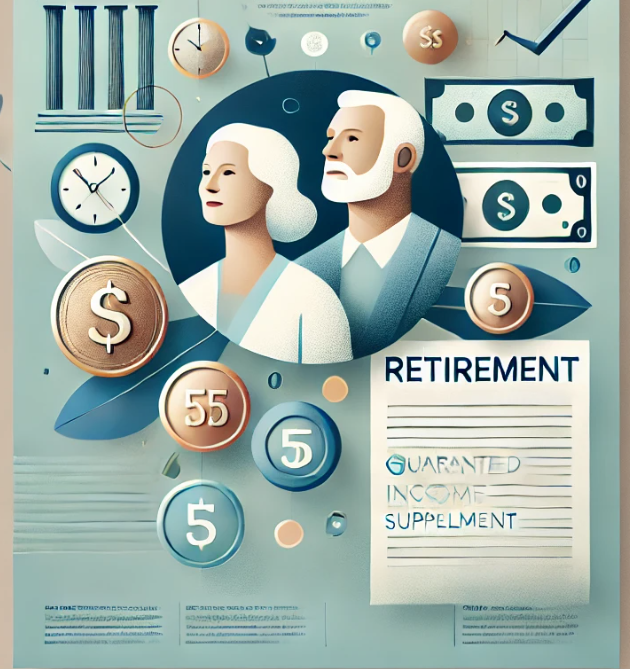This article continues our series on Canada’s retirement income options, following All About Canada’s Retirement System: The Old Age Security. Canada’s retirement benefits system is structured around three main pillars:
- Old Age Security (OAS)
- Canada Pension Plan (CPP) or Quebec Pension Plan (QPP)
- Private pensions and personal savings
In addition to OAS, the first pillar, there are additional supports for low-income seniors, including the Guaranteed Income Supplement (GIS), the Allowance, and the Age Credit.
This article will focus on the GIS—a monthly benefit for low-income seniors residing in Canada—to help you understand its eligibility criteria, benefits, and application process.
Disclaimer
The information shared in this article reflects the current laws, regulations, and rules applicable to Canadian residents as of the date of publication. While we strive for accuracy, please note that these rules may evolve, which could impact the relevance of the details provided. The content is intended for general informational purposes and should not be taken as personalized advice. For guidance tailored to your specific financial, legal, tax, or accounting situation, it’s essential to consult with qualified professionals in the relevant field.
I. GIS Eligibility
To qualify for GIS, you must:
- Be 65 or older,
- Receive the Old Age Security (OAS) pension,
- You are a Canadian citizen or a legal resident,
- You live in Canada
- Have an income below the maximum annual threshold established by the government.
To determine your eligibility, please read this article.
II. Applying for the Guaranteed Income Supplement
Service Canada may send you a letter indicating that you qualify for GIS, and payments will begin automatically. However, if you’re not automatically enrolled, you can apply using one of these options:
- Online Application: Through your My Service Canada Account.
- Paper Application: Complete form ISP-3550 (for OAS and GIS) or ISP-3025 (for GIS only) and mail it or bring it to a Service Canada office.
For subsequent years, once you file your tax return, your GIS eligibility is reassessed automatically. Note that eligibility for GIS will be suspended if you are incarcerated for two years or more.
To get an estimate of your OAS and GIS see the Old Age Security Benefits Estimator.
III. Types of Income Considered for GIS
The GIS amount you receive is based on your income and marital status. Only income other than OAS and GIS is considered, with some key sources listed below:
- Considered Income: CPP or QPP benefits, workplace pensions, RRSP withdrawals, investment income, rental income, and certain other government benefits.
- Exempt Income: OAS, GIS, Allowance payments, up to $5,000 of employment/self-employment income, TFSA withdrawals, and certain deductions like union dues and RRSP contributions.
This income threshold adjusts quarterly, and for couples, the combined annual income is used to determine eligibility.
IV. GIS Income Exemption
The 2019 Federal Budget increased the GIS income exemption amount from $3,500 to $5,000 and extended it to self-employment income. Now, up to $10,000 of combined employment and self-employment income can be partially exempted, with a 50% exemption applied on income above the $5,000 threshold.
V. GIS Clawback
The GIS is income-tested, and its benefit reduces by 50% for every additional dollar of income, often referred to as the “GIS clawback.” For some income levels, especially in higher income brackets, the clawback can reach 75% or more.
Example: Suppose a retiree earning $8,000 from CPP withdraws an additional $960 from an RRSP. This extra income reduces GIS by 50% or $480 annually, starting from the following July. Monthly GIS payments will decrease by $40/month over the year to reflect this.
At a certain income level, the GIS benefit will be reduced to zero. This income level varies depending on your marital status and other factors.
A Practical Example of GIS Exemption and Clawback
Assume that you earn $17,000 per year from the following sources:
- $3,000 from the Canada Pension Plan (CPP)
- $8,000 from employment
- $6,000 from self-employment
Your GIS clawback will be based on:
- $3,000 from CPP
- $1,500 from employment (a $5,000 exemption, and then the next $3,000 only gets ½ the normal clawback)
- $3,000 from self-employment (only 50% of the normal clawback applies)
Thus, you will have a clawback based on $7,500, even though your income is $17,000 per year from the above sources.
If you have questions regarding your GIS application, contact Service Canada at 1-800-277-9914 (Canada/US) or 1-613-957-1954 (outside Canada/US). For questions about your taxes, contact the Canada Revenue Agency at 1-800-267-5177 (Canada/US) or 613-952-3741 (all other countries).
VI. How to Minimize GIS Clawback
As income rises, GIS benefits decline. To maximize your GIS, consider these strategies:
- Increased Exemption: Recent changes allow up to $5,000 of employment or self-employment income to be exempted from GIS calculations.
- TFSA Contributions: Funds withdrawn from a TFSA are not counted as taxable income and thus do not impact GIS eligibility.
VII. Is GIS Taxable?
Unlike OAS and CPP, GIS benefits are tax-free. However, it’s essential to file an annual tax return since this determines GIS eligibility each year. The GIS is adjusted quarterly based on income thresholds updated in January, April, July, and October.
VIII. Impact of CPP on GIS Benefits
Since CPP income counts toward GIS eligibility, high CPP benefits may lead to significant GIS clawbacks. For low-income retirees, delaying CPP benefits until age 70 may not be advantageous due to these clawbacks. Starting CPP at age 60 might be a better option if GIS is anticipated, as it can allow retirees to save extra income in a TFSA, reducing future clawbacks.
Thank you for reading! Feel free to share your thoughts and questions in the comment section below—we’d love to hear from you!






